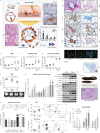TLR7/8 activation induces autoimmune vasculopathy and causes severe pulmonary arterial hypertension
- PMID: 37290790
- PMCID: PMC10356963
- DOI: 10.1183/13993003.00204-2023
TLR7/8 activation induces autoimmune vasculopathy and causes severe pulmonary arterial hypertension
Abstract
This study introduced a combination of autoimmune stimuli (TLR-7/8 agonist) and endothelial injury (Sugen) and established a novel rat model representing immune–vascular pathological events mimicking human PAH associated with autoimmune disorders
Conflict of interest statement
Conflict of interest: The authors have no potential conflicts of interest to disclose.
Figures

References
Publication types
MeSH terms
Substances
Grants and funding
LinkOut - more resources
Full Text Sources
Medical
